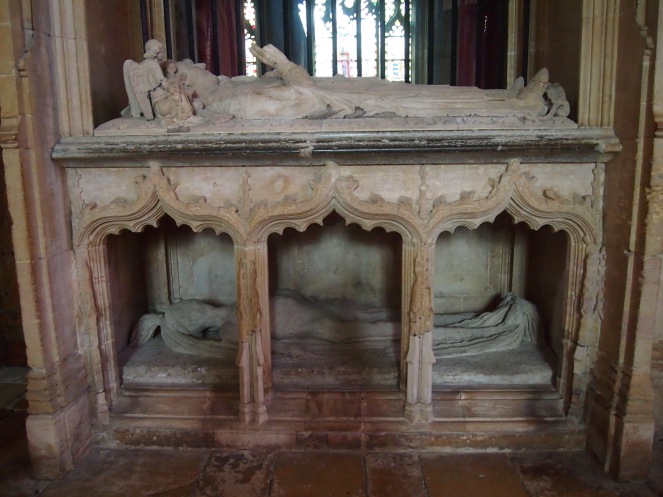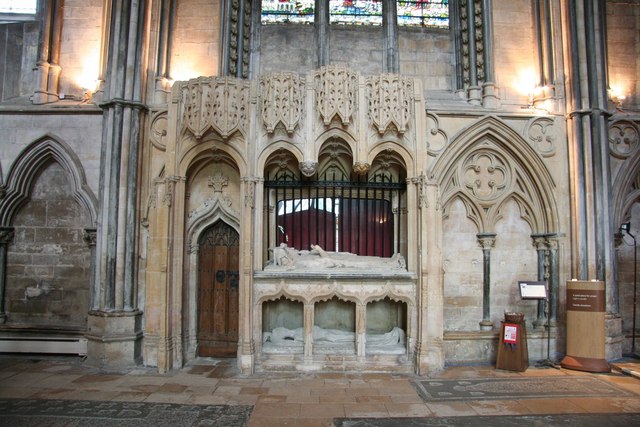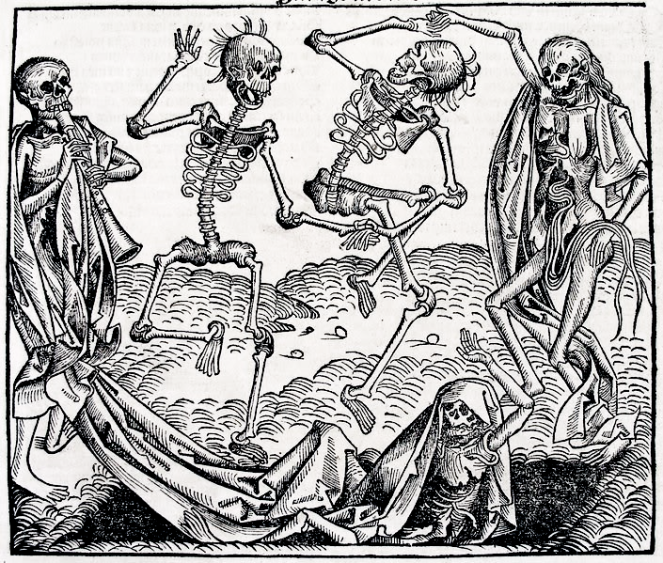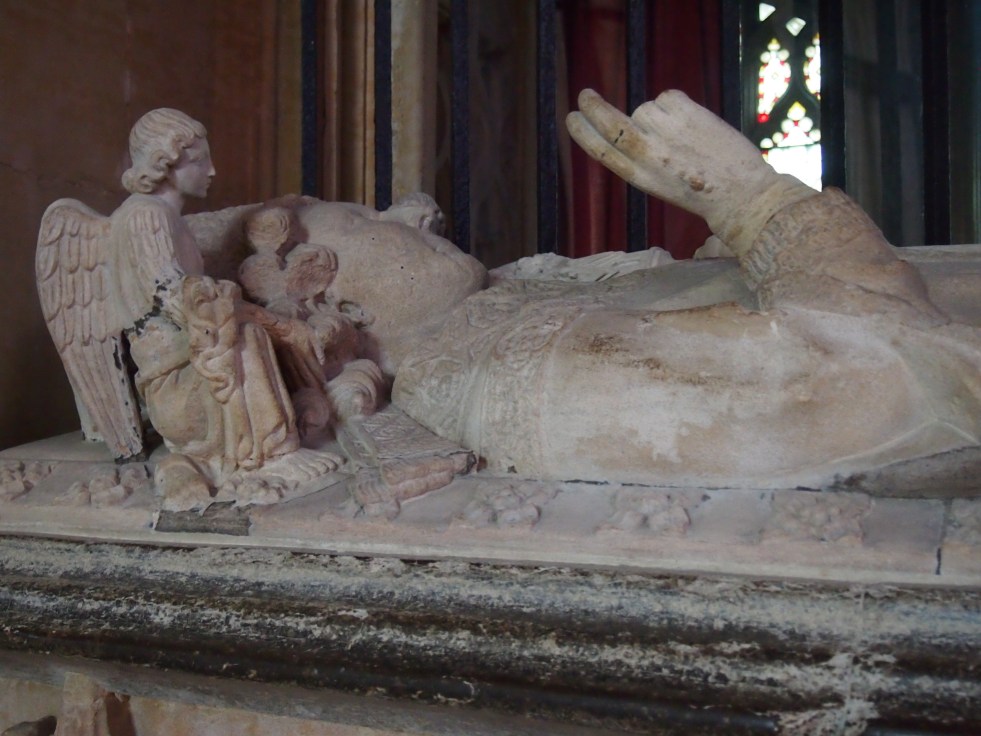At first, it looks like just another effigy. A man in bishop’s robes carved in stone lies in peaceful repose, one hand raised in blessing, his head guarded by an angel. But beneath the effigy is another figure – shockingly, this is the figure of a rotting corpse, wrapped only in a shroud. This is the cadaver tomb of Bishop Richard Fleming at Lincoln Cathedral, and it is the oldest one still surviving in England.

Cadaver tombs, or transi tombs as they are also known, began to be used in the 14th Century, after the Black Death had swept through Europe, killing at least one third and perhaps as much as one half of the population. Mortality on a such a vast, shocking scale would have been deeply unsettling to those left behind, and the macabre imagery of the cadaver tomb reflects people’s heightened preoccupation with death at this time. The cadaver sculpure could act as a memento mori, a reminder of death, and subverted the popular fashion for effigies to depict an idealised image of the deceased. In medieval Europe, where belief in Heaven, Hell and the afterlife was powerful, the cadaver tomb would serve as a sobering reminder to those viewing it that everyone must die.

Of course, such ornate and ostentatious tombs were only created for the priveliged few. Bishop Richard Fleming, the man commemorated by the cadaver tomb at Lincoln, was a powerful individual who founded Lincoln College, Oxford and died in 1431. The effigies of the rotting corpses of the rich and powerful were incredibly symbolic – not only did they show death as being the great leveller, but they have also been interpreted as being penitential. By choosing to have themselves depicted in a shocking state of physical decay, individuals were atoning for their worldly riches and power and hoping to gain salvation in the next world. Kathleen Cohen, in Metamorphasis of a Death Symbol, argues that this penitential role was the primary concern of transi tombs – that the inviduals who commissioned them were first and foremost concerned with the fate of their own souls, rather than simply seeking to have a tomb that would pass on a moralistic message to others.
As shocking as the imagery on Bishop Fleming’s tomb might seem to us today, English cadaver tombs tended to be more restrained than some of their Continental counterparts. Some depicted corpses being devoured by vermin, a far cry from a peacefully resting body. The elaborate transi tomb of René du Chalon depicts the young prince as a skeletal figure with strips of flesh hanging from the bones. His heart was originally enclosed in the effigy’s hand; it has since been lost.

The fashion for transi tombs began in Europe, but Bishop Fleming’s tomb was one of the very first in Britain. Such tombs were often commissioned by an individual before their death – perhaps Fleming’s choice of tomb had been inspired by tombs he’d seen or heard about in Europe. The rich continued to commission cadaver tombs for themselves until the 16th Century, with later examples – like that of René du Chalon, who died in 1544 – often being more elaborate and shocking than earlier transi tombs.
The popularity of cadaver tombs roughly coincided with another macabre artistic trend – the Danse Macabre, or Dance of Death. This typically featured skeletons and corpses breaking free of their graves and dancing, or perhaps taking a living person by the hand as they passed from life to death. Examples of Danse Macabre paintings have been found not only as prints, paintings and woodcuts but as wall paintings in public buildings or private residences. The cloister at Old St Paul’s Cathedral in London was once decorated with a Danse Macabre, and a mural still survives in St Nicholas’ Chapel at Haddon Hall in Derbyshire.
Like the cadaver tombs, the Danse Macabre reminded viewers not only of the inevitability of death, but also of death as the great leveller – even the rich and powerful could not escape it. Although both transi tombs and Danse Macabre images became less popular after the Protestant Reformation in the 16th Century, memento mori images (especially skulls) on portraits, graves and even items such as jewellery continued to be popular.

Bishop Fleming’s tomb was damaged during the English Civil War in the mid 17th Century, and restored during the Victorian period. Like other monuments and decorations in churches during the medieval period, it’s possible that the tomb was originally brightly painted, which would have made it even more striking and frightening. Today, many of the visitors to the magnificent Lincoln Cathedral probably walk past the tomb without realising the cadaver effigy is even there. It’s a strange relic of a very odd tradition that has somehow survived over the years, giving us an insight into one of the ways that the people of the medieval period tried to make sense of the dreadful mortality of the Black Death.
References and further reading
Kathleen Cohen – Metamorphasis of a Death Symbol: the Transi Tomb in the Late Middle Ages and the Renaissance, University of California Press, 1992 (accessed via Google Books)
A taste for the macabre – late medieval cadaver tombs, Medieval Church Art, 7th September 2008 http://medieval-church-art.blogspot.co.uk/2008/09/taste-for-macabre-late-medieval-cadaver.html
Transi de René de Chalon, Atlas Obscura http://www.atlasobscura.com/places/transi-de-ren-de-chalon


Morbidly fascinating. I had not heard of cadaver tombs before.
LikeLike
Thank you! I was not aware of them either before coming across this tomb at Lincoln – now that I know about them, I’m hoping to spot a few more. They are incredibly strange things.
LikeLike
Check out the tomb of Archbishop Henry Chichele in Canterbury Cathedral, it’s pretty similar to that one and it’s amazing.
LikeLike
Reblogged this on First Night History.
LikeLike
‘In medieval Europe, where belief in Heaven, Hell and the afterlife was powerful, the cadaver tomb would serve as a sobering reminder to those viewing it that everyone must die. Of course, such ornate and ostentatious tombs were only created for the priveliged few.’ – I’d like to think that those ones served as a comfort of sorts to the unprivileged many, reassuring them that even the rich so-and-sos were destined to end up as worms’ happy meals 🙂
LikeLike
Yes, it must have been comforting for people to remember that the great and the good were destined to end up as worm food, same as everyone else 🙂 I’m sure a few people have also had a bit of a laugh over the years at the sheer oddness of the cadaver tombs!
LikeLike
Was Rene of Chalon’s body also subjected to another odd practice which has been known throughout the Middle Ages: Separate burial of the heart?
The transi in the picture is a standing statue which doesn’t seem to incorporate space for the rest of the body and it’s in Bar-le-Duc while his body rests in the family mausoleum in the Grote Kerk in Breda
LikeLike
Separate burial of the heart and other viscera seems to have been quite a common practice amongst elites during the Middle Ages – I’ve come across many references to nobles and royals whose hearts were buried separately to their bodies. It seems to have often been for spiritual reasons (at the time, it was believed that the soul resided in the heart) but I suspect that sometimes it was also a practical decision – it was easier to move a heart to a desired place of burial than an entire body.
LikeLike
I suspect there’s another practical element too – it allows one person to show devotion or connection to more than one place! Richard the Lionheart’s heart is buried in Rouen cathedral, but his body is with his mum in Fontrevraud Abbey.
LikeLike
Very true! I suppose having more than one tomb meant that you’d get more prayers said for your soul too.
LikeLiked by 1 person
Thanks for a great post, Caroline. I haven’t spotted one of these yet and its worrying to think about what you miss if you don’t look down. Strangely compelling.
LikeLike
I wonder how many people have walked past this tomb and not noticed the cadaver effigy! It’s a fascinating and incredibly odd monument and I’m really glad that, among the many monuments at the cathedral, that this one caught my eye.
LikeLiked by 1 person
Hexham Abbey in Northumberland has a 15th century painted wood screen, now located behind the choir, part of which pictures the Dance of Death. Each panel shows Death as the Great Leveler, escorting a person of a different social status.
LikeLike
That sounds absolutely stunning! I would love to visit Hexham Abbey one day, it sounds as though it is a fascinating and beautiful place.
LikeLike
Hello Caroline, I recently discovered your blog and am enjoying it so much. There’s a fantastic cadaver tomb in one of my local churches – St Mary’s at Worsbrough. The tomb is that of Roger Rockley, and the effigy is a most unusual carved wooden one.
LikeLike
Wow – I just looked up Roger Rockley’s tomb and what an amazing, creepy tomb it is! Fantastic that it’s lasted so long.
LikeLike
There is a cadaver tomb in the Parish church of St Mary & St Hardulph, Breedon on the Hill in Leicestershire. The wall monument erected in 1598 to Mrs Shirley who died in 1595. Above the cadaver are 5 kneeling figures, Mrs Shirley & her husband, a daughter and two sons.surmounted by two deep coffered arches. There are also two infants in cradles.
Also in the church is some high relief Saxon carving thought to date from the Nineth Century. The history of the church date back to the Seventh Century.
LikeLike
Reblogged this on texthistory and commented:
A Lost art form. Grotesque, engrossing , macabre
LikeLike
As a guide in Lincoln Cathedral we always tell the tale of how the Dean’s Verger was giving a tour to some school children. He explained the cadaver tomb saying “In life we can have jewels and riches (pointing above) but in death (pointing below) we all turn to dust. So what does this tell you?”…..then one young boy put his hand up and said “Never sleep on the bottom bunk!!”
LikeLike